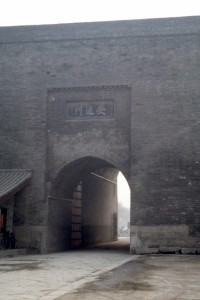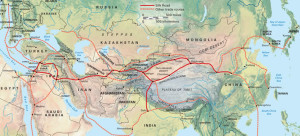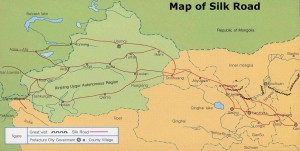A rough description of the geography of the Silk Road
One of the most fascinating journeys one can make is following the Silk Road, or Silk Route, that ancient trading route capturing the imagination of so many. In fact, it is not one road, but a network of trails and tracks that led from Xi’an – ancient Chang’An, China’s capital -, west through a narrow corridor between the Tibetan plateau to the South and Qing Shan mountains to the North to Dunhuang, at the edge of the Taklamakan Desert. From here, the Silk Route branched into a northern and southern arm, along the edges of the desert, to converge again at the other end, in Kashgar. From this western-most part of China several tracks crossed the Himalayas, to end up in British India, now Kashmir and Pakistan, and in Afghanistan, to continue through Iran to Aleppo in present-day Syria, from where Europe could be served overland or by sea. Another branch went from Kashgar north past the ancient caliphates of Samarkand, Bukhara and Khiva, into Russia and on to Europe. (see for a continuation in this direction the Central Asia blog)
The Silk Road has entertained illustrious travelers like Xuan Zhang, a disillusioned Chinese who set out to bring the first Buddhist scriptures to China and so introduced a new – if not the first – religion into the Middle Kingdom more than 2000 years ago. Marco Polo, if he indeed ever traveled to China, came along the Silk Road, and so did the European collectors who came to Western China at the beginning of the 20th Century in search of Buddhist art treasures and manuscripts.
With the opening up of China, many intrepid individual travelers have made the journey in recent years, and many have written about their adventures. So did we, in 1998, and this is the travelogue of that trip. Our aim was to travel the Chinese part, from Xi’an to Dunhuang, then north around the Taklamakan, and across the Karakoram Highway into Pakistan’s Hunza Valley, to end in Islamabad. We had some seven weeks for this adventure, way less than any ancient traveler would have needed to even travel a small part of the road, but such are the advantages of modern times.
NB: the maps, from http://www.silkroadproject.org & http://www.topchinatravel.com, respectively, show (above) how the Silk Road skirted the high mountains, and circumvented the desert before working its way to Syria, and (below) how the Silk Road branched out from Dunhuang westwards, to negotiate the Taklamakan Desert.
Continue: Start in Xi’an












